

 The South African
The South African
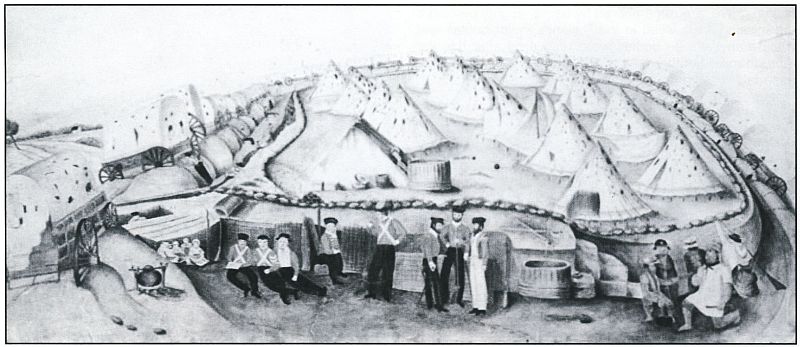
Fort Port Natal (From a watercolour of the British camp at Fort Port Natal in 1842:
Local History Museum Collection, Durban)
All photographs by the author with the exception of the Fort Port Natal watercolour
Introduction
Tuesday, 23 May 2017, marked an important date in Durban's historical tapestry - it was the dodransbicentennial (175th) anniversary of the commencement of the Battle of Congella in the greater city of Durban. From a military historical perspective, the Congella battle site was actually named after former Zulu barracks (known as an ikhanda), called kwaKhangela. This was established by King Shaka kaSenzangakhona (c 1787-1828) to keep a watchful eye on the nearby British traders at Port Natal. The full name of the place was kwaKhangela amaNkengane ('place of watching over vagabonds').
Shortly after the Battle of Blood River (isiZulu: iMpi yaseNcome) on 16 December 1838, the Republic of Natalia was established by the migrant Voortrekkers. These were Afrikaner Boers, mainly of Dutch descent. Natalia stretched from the Tugela River to the north to present day Port St Johns at the uMzimvubu River to the south. It sought an independent port of entry, free from British control, by conquering the Port Natal trading post, which had been settled by mostly British traders on the modern day site of Durban. However, the governor of the Cape Province, Maj-Gen Sir George Thomas Napier, KCB (1784-1855), stated that his intention was to take military possession of Port Natal (Gillings, 2000, p 6) and prevent the Afrikaner Boers from establishing an independent republic upon the coast with a harbour through which access to the interior could be gained.
The Battle of Congella began on 23 May 1842 between British troops from the Cape Colony and the Afrikaner Boer forces of the Republic of Natalia. The battle ended in a British victory after the successful and heroic ride of Dick King to Grahamstown for reinforcements.
This article commemorates Durban's famous military battle and its association with one of Durban's and South Africa's Citizen Force units, Congella Regiment (1980-2000), headquartered for most of its duration in the greater Durban area not far from the original Zulu barracks' outlook post.
Background
The Great Trek (Afrikaans: Die Groot Trek) was an eastward migration of Voortrekkers who, from 1836 onwards, travelled by wagon from the Cape Colony seeking to live beyond the Cape Colony's British colonial administration. During the Great Trek, many Voortrekkers left the Cape Colony overland to escape British rule and were looking for land to farm. Some had crossed the Drakensberg Mountains and settled in the area known as Natalia.
Soon after the defeat of the Zulu king, Dingane kaSenzangakhona (c 1795-1840) at the Battle of Blood River, the Boer Republic of Natalia was founded. The capital was established in Pietermaritzburg, and Durban was considered part of it. The Boers resumed their farming lifestyles in the Republic of Natalia, but the Zuluspeaking inhabitants of the region had some misgivings about these newcomers. War soon followed.
Furthermore, the British Government had never recognised the sovereignty of the Republic of Natalia and its burghers continued to be regarded as subjects of the Crown (Gillings, 2000, p 6). So the Cape Government became aware of the unofficial Boer republic, the attacks on British subjects at Port Natal, as well as the continued conflict with the Zulu kingdom. In March 1842, the Cape Governor decided to send a small force, under Capt Thomas Charlton Smith, to occupy Port Natal (since most of the residents were English), to take possession of the Republic of Natalia from the Boers and to resolve and settle the disputes with the amaZulu.
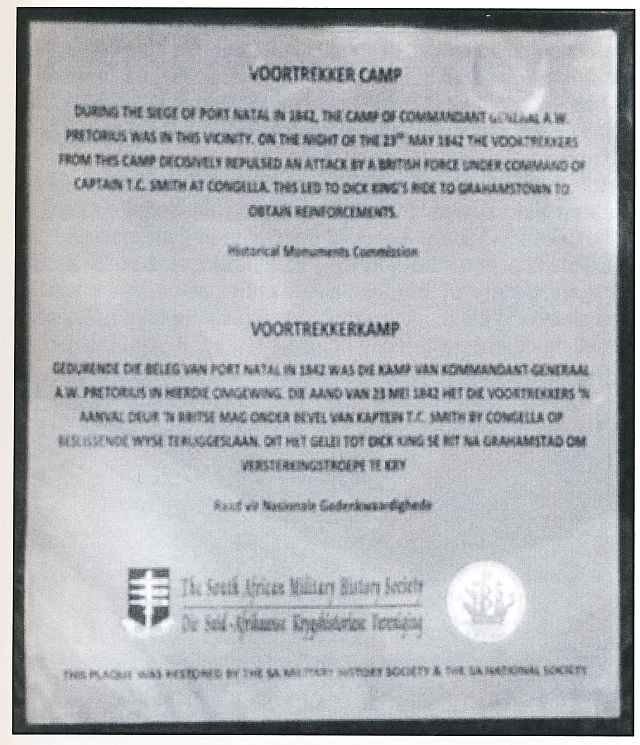
Plaque in Congella Park, Umbilo, Durban, commemorating the
1842 Voortrekker camp of Cmdt-Gen Andries W Pretorius.
Farce at the Battle of Congella
On receipt of orders from Maj-Gen Sir George Napier, Capt Smith left his post at Fort Mngazi (the furthest-flung British garrison on the Cape Colony frontier) for Port Natal. His force comprised 263 officers and men, an 18-pounder howitzer and two 6-pounder field guns, and included elements of the Royal Artillery, Royal Engineers, Sappers and Miners, Cape Mounted Rifles and two companies of his own regiment, 27th (Inniskilling) Regiment of Foot. (This was an Irish infantry regiment of the British Army, formed in 1689, which would amalgamate with the 108th [Madras Infantry] of Foot in 1881 to form the Royal Inniskilling Fusiliers).
On 1 April 1842, Capt Smith crossed the uMzimvubu River (isiXhosa name meaning 'place of the hippopotamus') into Natalia (Saks, 2004, p1). When he was near the uMkhomazi River (in isiZulu, there is an association with umkhomkazi, a whale cow), he ignored protests made by the Boers. On 4 May 1842 he reached Robert Newton Dunn's (1796-1847) farm, 'Sea View', situated some 10km ('half a dozen miles') from Durban harbour, and camped there. The next day his force crossed the Umbilo River and marched through Congella - meeting no resistance from the few Boer settlers encountered there. Capt Smith then instructed his men to set up their tents and position the wagons in laager formation at Fort Port Natal (now known as the Old Fort, Durban).
In the meantime, realising the gravity of the situation at Port Natal, Boer Cmdt-Gen Andries W Pretorius (1798-1853) commenced assembling a commando force of the Republic of Natalia at his laager at Congella. The village of 'Kongela' was thereby strongly defended upon the arrival of British forces (Lonsdale, 1981, p2). Cmdt-Gen Pretorius had 364 volunteers under his command. Negotiations between Capt Smith and Cmdt-Gen Pretorius were unsuccessful.
At 23h00 on the moonlit evening of 23 May 1842, Capt Smith, 'after mature deliberation' (Russell, 1971, p24) set out for the Boer laager at Congella with 138 officers and men (of whom 109 were from the 27th (Inniskilling) Regiment of Foot), supported by the two field guns (Binckes, 2013, p 441). He decided to take a circuitous route along the beach (Saks, 2004, p2), where the tide was rising, in order to attack the well-defended village of 'Kongela', which was 5km (three miles) from the British camp.
The British forces had to skirt a dense thicket of mangrove-trees, held by an advance party of Boers and who then opened fire on them (Cmdt-Gen Pretorius had ordered 'his men not to open fire until the British forces were within point-blank range' (Tucker, nd, p3)). Twenty-five of the best Boer marksmen (Binckes, 2013, p 441) were well hidden in the Kongela thicket, whereas their opponents (the British) were completely exposed against the moon-lit sands and waters of Durban's harbour (Saks, 2004, p2).
Capt Smith's attack failed disastrously. Every time the 'Redcoats' or 'Rooibatjes' (Russell, 1971, p27, as the Boers termed the 27th [Inniskilling] Regiment of Foot) stood up in the bright moonlit sky to reload, they offered to the Boers a target such as every marksman dreams of but seldom sees. Purposefully, every well-directed shot fired by the Boers counted ...
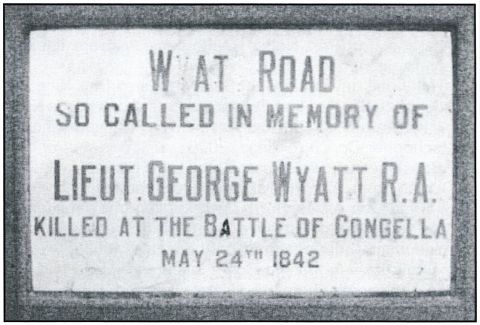
Memorial plaque for Lt George Wyatt at Wyatt Road Military Cemetery, Durban
The Boers won a major battle. Capt Smith had lost many of his men, his 18-pounder had been captured, the two field guns abandoned during their retreat, muskets and pouch-belts and ammunition had been discarded and they littered the beach (Binckes, 2013, p442). Furthermore, three men drowned as they were caught by the rising tide. The final count was 22 dead, 31 wounded and six missing in action, making this disastrous night attack the cause of 59 casualties (or 42% of the British force) which had set out. The three officers who fell were Lt G Wyatt of the Royal Artillery (shot dead), while Capt J F Lonsdale and Lt B Tunnard were severely wounded (The Mercury, 1904; Lonsdale, 1981, p2).
On the Boer side, four men fell 'en andere Helden' ('and other heroes') mainly during the closing stages of the battle. The order to retire was given by Capt Smith (Trimble, 1876, p103). The Boers harassed them all the way back to Fort Port Natal (Tucker, nd, p 3) where Capt Smith's force was then promptly besieged by the Boers. The Boers, elated at their unexpected success, opened their attack with their long-barrelled hunting guns on the besieged British force (Russell, 1971, p26). Capt Smith was cut off from his supplies and his men were placed on half allowance (Trimble, 1876, p103). Such half-rations comprised biscuit dust, alternating with biscuit and rice (Russell, 1971, p26).
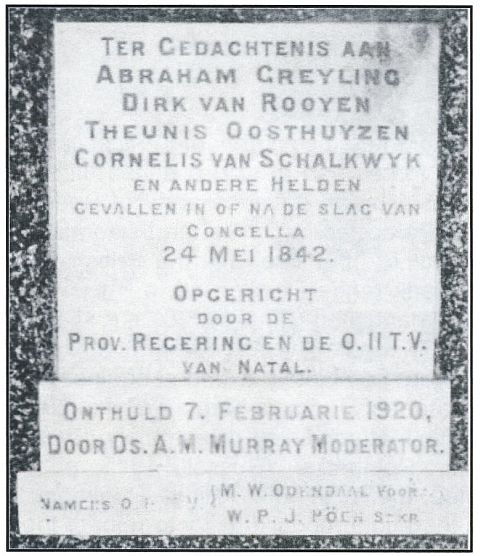
Memorial plaque for Boer casualties situated in Bayhead, Durban
Capt Smith realised he urgently needed to request reinforcements from the Cape Colony. Richard Philip 'Dick' King (1811-1871), an English trader at Port Natal, volunteered to ride 970km (600 miles) to Grahamstown, the military headquarters (Russell, 1971, pp 28-29), in order to request the assistance of its British garrison (Marschall, 2005, p84). King, accompanied by his sixteen year old Zulu servant, Ndongeni kaXoki (Gillings, 2000, p7; Marschall, 2005, p82), set off and made his famous ten-day horseback ride (seven days less than the time normally taken) through the harrowing wilderness and fording some 120 rivers to summon relief for the besieged British garrison at the Fort Port Natal. Reinforcements were immediately dispatched to Natalia.
Thirty-one days after Capt Smith recruited Dick King, on 24 June 1842, the first reinforcements from Algoa Bay (now known as Port Elizabeth) arrived at Port Natal aboard the schooner Conch (Gillings, 2000, p7). This was one of the British vessels which carried the relief parties, including 100 men from 27th (Inniskilling) Regiment of Foot (and Dick King as a passenger). These British troop reinforcements were in time 'to save Capt Smith's garrison from imminent surrender or starvation' (Lonsdale, 1981, p4).
Soon the surrounding Boers dispersed inland and the Battle of Congella therefore ultimately ended with a British victory. Nevertheless, the men of the 27th (Inniskilling) Regiment of Foot were thirsting for revenge, desiring to burn homesteads and follow the Boers inland, but fortunately 'the force of discipline in the Inniskillens was more effective than of reason, and restrained Captain Smith's murmuring men from open mutiny' (Russell, 1971, p48). The Royal Inniskilling Fusiliers had thereby carved an honourable niche in the early history of Port Natal and Durban.
A century later (in 1942) the city of Durban commemorated the centenary of Capt Smith's forces defending the Old Fort against the Boers at the Battle of Congella.
Nowadays, the Old Fort of Durban enshrines all the military history of Durban. It is a quiet place, quiet with a quietness of itself, although so close to Durban's noisy and bustling cosmopolitan city centre.
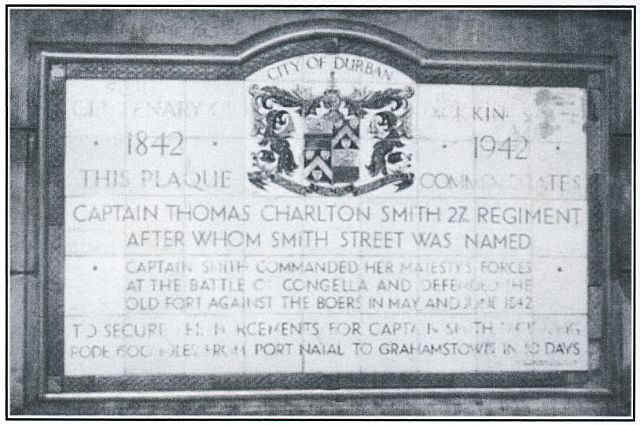
Ceramic tiled plaque for Capt Smith's forces in Francis Farewell Square, west of the Durban City Hall
Thirty-eight years after this city of Durban's centenary commemoration (ie 138 years after the Battle of Congella), a newly-established South African Defence Force (SADF) Citizen Force unit, Congella Regiment, was formed, and associated itself with the Royal lnniskilling Fusiliers.
Establishment of Congella Regiment
Congella Regiment came into existence as a result of a new SADF military policy during 1980, whereby all members of Commando units who still had camp commitments to the State, were posted to SADF Citizen Force units (unless classified as 'area bound').
Cmdt I Deetlefs, at that stage the Officer Commanding (OC) Umkomaas Commando and scheduled to take over as OC Bluff Regiment, prevailed upon the OC Natal Command to allow him a personal selection of his leader group from various Commando units. On 28 November 1980 the following members (with their substantive ranks) were transferred to Bluff Regiment: Cmdt I Deetlefs, Maj E J Spalding, Capt D J Edgcumbe, Capt A J Macquet, Capt A M Rowe, Capt J K S Thorpe, Lt G Linscott, WO2 L N Kilminster and WO2 L B Stanway. Also transferred was the Administration/Clerical assistant, Mrs R Robertson.
Bluff Regiment, as the unit was originally named, came into 'official' existence with effect 1 January 1981 and comprised Citizen Force members from Bluff Commando, Durban North Commando, Durban South Commando, Highway Commando, South Coast Commando and Umgeni Commando. With effect from October 1982, the unit's name was officially changed to Congella Regiment. The unit was English-speaking.
The newly-established unit was housed in the premises of Bluff Commando which were located at Bayhead in a four-storey building belonging to the State Fuel Farm (Pty) Ltd. Early in 1984, the unit relocated to the former Good Shepherd Home, Blamey Road, Montclair, Durban which became its permanent home until its disbandment early in 2000.
Congella Regiment's unit badge incorporated the Royal Inniskilling Fusiliers' insignia, a three-turreted castle, surrounded by a wreath of proteas and roses symbolising the historical association of South Africa with Great Britain. The unit adopted the isiZulu motto, 'khangela amaNkengane' which reflects the Zulu influence in the shaping of KwaZulu-Natal's military history (Group 10 Colour presentation, 1990, p 6).
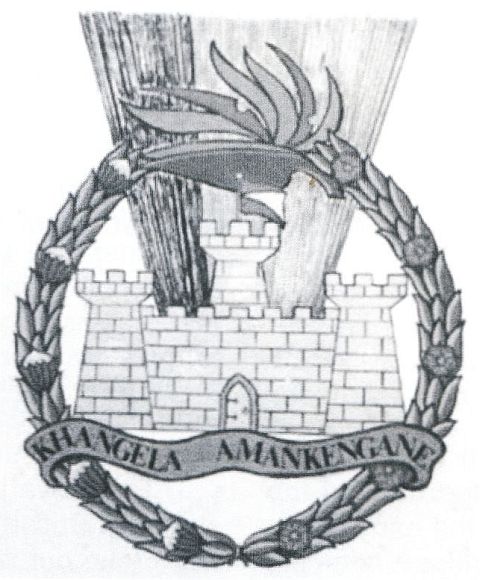
Unit badge of Congella Regiment
Four Officers Commanding served Congella Regiment:
Cmdt I Deetlefs (1980-1984)
Cmdt D J Edgcumbe (1984-1989)
Cmdt K R Brewis (1989-1995)
Lt Col* J A Moxham (1995-2000)
* The former rank title of Commandant was substituted with Lieutenant-Colonel.
In its heyday, Congella Regiment comprised some 1 500 Citizen Force members and prided itself on some unique specialised operational capabilities such as a Tactical Support Team for daunting rural and urban operational tasks and a dog-handler section for operational duties. The dog-handler section also gave public demonstrations to Durban's citizens. Congella Regiment's Regimental Pipe Band was on display on numerous occasions and participated in some of Durban military tattoos.
The 30th March 1984 was a black day in the history of Congella Regiment. Four of its members were killed (with only one survivor) when their South African Army land rover was travelling from the KwaZulu-Natal South Coast via Eston to Richmond, Natal Midlands. Approximately 15km from Richmond, the trailer from an out-of-control oncoming articulated truck broke loose, overturned and spilt its nine-ton load of wooden logs. The land rover was crushed. As a result of this fatal road accident, 23 May was declared by the unit as Congella Day.
Congella Regiment participated in border operations in the then South African protectorate of South West Africa (now Namibia), as well as near Jozini in northern KwaZulu-Natal. The unit was deployed in both rural and urban counter-insurgency operations. Prior to the 1994 general elections, it conducted regular township patrols to combat civil unrest prevalent at that time. Like the Royal Inniskilling Fusiliers, the men of Congella Regiment displayed a good force of discipline during these operations. Congella Regiment had thereby carved an honourable niche in the modern-day history of Durban.
The unit was disbanded (along with other Citizen Force and Commando units) after a decision by the second post-apartheid President of South Africa, Thabo Mvuyelwa Mbeki (1942 - ), to phase out the commando system and replace it with sector policing under the leadership of the South African Police Services. Congella Regiment's existence in Durban thereby succumbed to an ignominious end (Deetlefs, 2017).
Cmdt Deetlefs continued to serve the South African Army (with the rank of colonel in the Citizen Force Council). In 1997 he was appointed, with the rank of Major-General, to the post of Chief of Defence Force Reserves (C Def Res) in the South African National Defence Force (SANDF). During his tenure as C Def Res he wrote the order that led to the demise of conscription, effectively releasing all White males in South Africa from further compulsory military service obligations (Deetlefs, 2017). In 2003, Maj-Gen Deetlefs SSAS PG SM JCD retired from the SANDF.
Concluding remarks
In the context of Durban's historical tapestry, the Battle of Congella and Congella Regiment both occupy places of military significance. Congella Day, 23 May, is therefore an important date of celebration and remembrance in the City of Durban's history. We should pause to remember those who served and made sacrifices in both the Battle of Congella and for Congella Regiment.
Notes Udo Richard Averweg (rtd) served as a commissioned officer with Congella Regiment. Two earlier and adapted versions of this text appeared in the Independent on Saturday and the Daily News newspapers on 20 May and 24 May 2017 respectively.
Selected Bibliography
Binckes, R, The Great Trek: Uncut (300 South Publishers [Pty] Ltd, Pinetown, South Africa, 2013), Chapter 31, pp 435-52.
Deetlefs, I, Personal communication, 10 April 2017.
Gillings, K, Battles of KwaZulu-Natal (Art Publishers [Pty] Ltd, Durban, 2000), pp 6-7.
Group 10 Colour Presentation, 11 August 1990 (brochure).
Lonsdale, F M, 'The Battle of Congella' in Military History Journal, Vol 5, No 3, June 1981.
Marschall, S, 'Negotiating Public Memory: The Dick King Memorial in Durban' in Southern African Humanities, Vol 17, December 2005, pp 81-99.
Russell, G, The History of Old Durban and Reminiscences of an Emigrant of 1850 (T W Griggs & Co [Pty] Ltd, Durban, 1971), Chapter II, pp 21-57.
Saks, D, 'The Real "First Anglo-Boer War": The Siege of Port Natal, 1842' in Military History Journal, Volume 13, No 1, June 2004.
'The Battle of Congella. 52 years ago' in The Mercury, 1904.
Trimble, W C, Historical Record of the 27th Inniskilling Regiment (W M Clowes and Sons, Charing Cross, London, 1876).
Tucker, A R, 'The Congella Incident: Natal 1842' in Savage and Soldier Online. Retrieved on 10 February 2017, from http://www.savageandsoldier.com/articles/africa/ congella.html
Return to Journal Index OR Society's Home page
South African Military History Society / scribe@samilitaryhistory.org